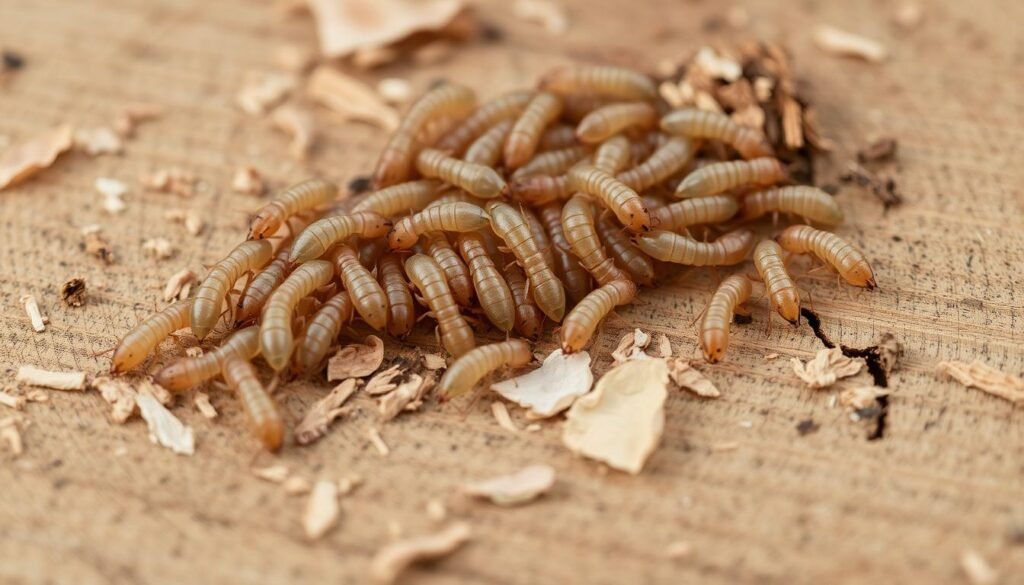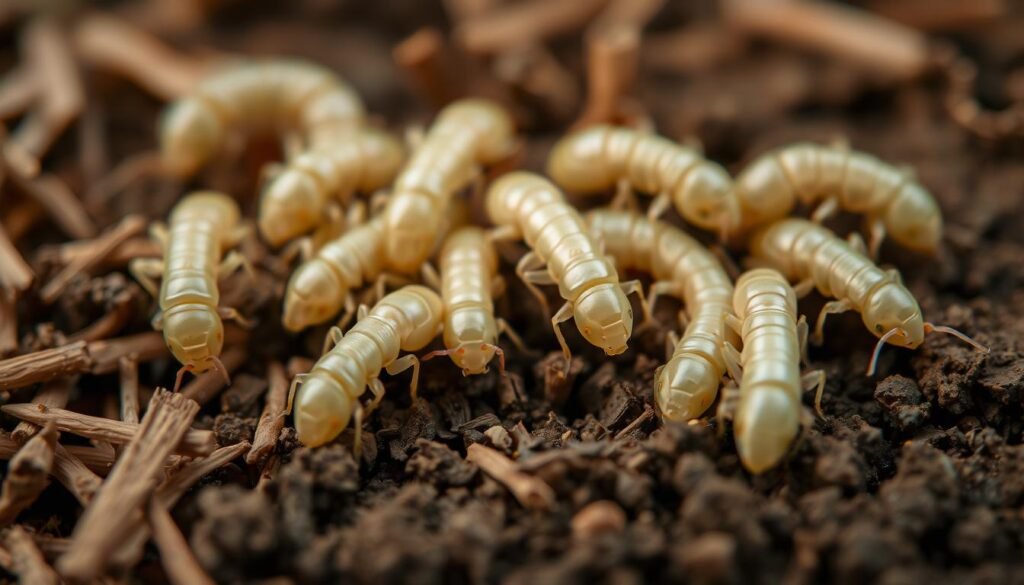Termites cause billions in damage yearly across the U.S. Baby termites, or nymphs, are the young members of a termite colony. They’re small, pale, and look like tiny adult termites.
These young termites can’t damage structures directly. However, they grow fast into adults that can cause major harm. Knowing about baby termites helps stop infestations early.
Table of Contents
ToggleKey Takeaways
- Baby termites, or nymphs, are the immature members of a termite colony.
- They are small, pale, and resemble miniature adult termites.
- Baby termites cannot directly damage structures, but they will quickly grow into destructive adults.
- Termite colonies can expand rapidly, with the queen laying thousands of eggs.
- Understanding baby termites is crucial for preventing and controlling termite infestations.
Introduction to Baby Termites
What Are Baby Termites?
Baby termites, or nymphs, are young members of a termite colony. They hatch from the queen’s eggs and go through molting stages. These pale insects lack wings and hard exoskeletons but are vital to the colony’s growth.
Termite colonies have diverse members. Workers make up 90-98% of the population. Soldiers constitute 2-4% in Eastern subterranean termites and up to 10% in Formosan termites. The queen and king can live for 15 years, producing thousands of eggs daily.
Mature colonies range from 50,000 to several hundred thousand Eastern subterranean termites. Formosan termite colonies may exceed one million individuals. New colonies start small, with fewer than 50 termites in the first year.
After two years, colonies grow to a few hundred termites. It takes about five years for a colony to invade buildings or produce swarmers.
Baby termites are crucial for colony growth and survival. As they grow, they take on tasks like foraging, caring for young, and nest maintenance. Their small size makes them vulnerable, but they’re essential to the colony’s success.
The Life Cycle of Baby Termites
Baby termites, or nymphs, start as eggs laid by the queen. The queen can lay thousands of eggs daily. Once hatched, worker termites care for the nymphs in special nursery chambers.
Nymphs go through several molting stages as they grow. They develop into adults with specific roles in the colony. These roles include workers, soldiers, and reproductive swarmers.
The queen’s egg-laying ability leads to rapid colony growth. This makes it crucial to spot and deal with infestations early.
| Termite Life Cycle Stages | Duration |
|---|---|
| Egg | 7-10 days |
| Nymph | 1-2 months |
| Worker | 1-2 years |
| Soldier | 1-2 years |
| Reproductive (Swarmer) | 2-3 years |
The termite life cycle takes about a year to complete. Workers and soldiers live for one to two years. Queens can survive for over a decade in good conditions.
“Termite colonies can grow to over a million individuals, with the queen capable of laying thousands of eggs per day. This rapid colony growth makes early detection and intervention critical in preventing significant structural damage.”
Knowing the baby termite life cycle helps control infestations. Staying alert to termite activity signs is key. This allows for quick action to protect homes from these wood-eating pests.
Identifying Baby Termites
Appearance and Characteristics
Baby termites, or nymphs, can be tricky to spot. They’re small and look like other insects. These young termites are pale white or clear, with straight antennae and thick waists. Unlike adults, baby termites don’t have wings.
Small, soft-bodied insects near termite eggs might be baby termite identification clues. The termite nymph appearance is unique, with undeveloped features and no wings. Knowing termite larvae characteristics helps tackle infestations early.
Termite larvae growth depends on colony size, food, and temperature. These factors affect how quickly they develop. Nematodes, worms used for termite control, show results within three days of use.
Pest control experts have the tools to handle baby termites in buildings. They’re better equipped than individuals trying to fight termites alone. Spotting baby termites early helps prevent severe property damage from growing colonies.
“Accurate identification of baby termites is crucial for addressing an infestation before it escalates and causes significant damage to your property.”
The Role of Baby Termites in a Colony
Baby termites, or nymphs, are crucial for a termite colony’s growth. They help with nest-building, food gathering, and caring for the queen and young. These tiny termites can’t damage structures directly but support the colony’s success.
As nymphs grow, they can become workers, soldiers, or reproductive termites. This change helps the colony expand and defend itself. Worker termites must feed termite larvae, as they can’t digest food alone.
- Most termite larvae in a colony develop into workers due to higher demand for this role.
- Larvae molt several times before reaching maturity and can develop into workers, soldiers, or reproductives based on colony needs.
- Worker termites may later transform into soldiers or reproductives as required by the colony.
- Larvae that become alates can grow wings and reproduce, helping the colony expand.
Baby termites are key to the termite colony social structure. Knowing this helps homeowners spot potential threats. Termite larvae can indirectly damage homes by relying on workers for food.
Their death can weaken the colony. However, this doesn’t lessen the risk to homes.
“Termite damage costs Americans over $5 billion annually, and most insurance plans do not cover the damage.”
To stop baby termites in termite colonies, use professional pest control. This can prevent silent, costly home destruction over time.
Reproduction and Egg-laying in Termite Colonies
Termite colonies thrive thanks to the queen’s incredible egg-laying abilities. She can produce thousands of termite eggs per day, rapidly growing the colony. As the termite colony grows, new queens may emerge, boosting egg production even more.
The queen’s amazing reproductive capacity is key to termite infestation success. This highlights why quick action is crucial to stop colonies from getting too big.
Queen Termite’s Reproductive Capacity
The queen termite can lay up to 36,000 eggs daily, far more than most insects. This allows colonies to grow fast, sometimes reaching millions of termites. Unlike ants, male termites live after mating.
The queen needs regular fertilization to keep up her impressive egg production. This process helps maintain the colony’s rapid growth over time.
| Termite Caste | Lifespan | Colony Size |
|---|---|---|
| Queen Termite | Up to 60-70 years | Millions of individuals |
| Worker and Soldier Termites | 2 to 5 years | Thousands to millions |
| Primitive Termite Families | N/A | Hundreds to thousands |
| Advanced Termite Families | N/A | Thousands to millions |
The termite queen’s reproductive capacity is vital for colony growth and survival. Knowing this lifecycle helps spot and prevent termite infestations in homes early.
Baby Termites and Termite Infestations
Baby termites play a vital role in growing colonies. As the queen lays more eggs, the colony expands rapidly. These juveniles mature into destructive adults that harm wooden structures.
Termite infestations cause billions in damage annually in the US. A queen can lay eggs daily for up to ten years. In just five years, a colony can grow from 1,000 to 300,000 workers.
Early detection of baby termites is crucial. It helps prevent extensive and costly damage to homes and businesses. Addressing infestations promptly can save property owners significant expenses.
- Termite nymphs are typically only ¼ to ½ inch long when they hatch.
- Most baby termites develop into swarmers, workers, soldiers, or queens.
- Baby termites eventually develop into adult termites, known for their destructive eating habits.
MightyMite Termite Services boasts an industry-best “no call-back rate”. They offer naturally derived treatments with low environmental impact. Americans spend about a billion dollars yearly on termite damage repair and control.
“Baby termites undergo molting, shedding their exoskeletons numerous times as they grow in size towards maturity. Most baby termites develop into alates (swarmers), responsible for reproduction and creating new termite colonies.”
Baby termites signal a growing infestation that needs immediate attention. Early identification and treatment can prevent extensive damage to your property. Don’t ignore these tiny invaders – act quickly to protect your home or business.

Signs of a Termite Infestation
Spotting early termite signs is vital for homeowners. Termite activity indicators can reveal issues before major damage occurs. Quick action can prevent costly property repairs.
Homeowners should watch for common markers. These clues help identify and address termite problems early. Prompt detection is key to protecting your home.
Common Indicators of Termite Activity
Mud tubes on exterior walls are a clear sign of termite activity. These tubes are termite highways to food sources. They often indicate an active infestation.
Other indicators of termite presence include hollow wood and discarded wings. Bubbling paint or crumbling drywall may also signal termites. These signs can reveal hidden infestations.
Baby termites are hard to see. But visible clues can point to a colony’s presence. Early detection helps prevent widespread property damage.
| Termite Activity Indicators | Description |
|---|---|
| Mud Tubes | Pathways created by termites to access food sources, often found on exterior walls |
| Hollow or Damaged Wood | Termites consume wood from the inside out, leading to structural weaknesses |
| Discarded Wings | Shed by swarming termites as they leave the nest to establish new colonies |
| Bubbling Paint or Crumbling Drywall | Signs of termite damage hidden beneath the surface |
Stay alert for these common signs of termite activity. Quick action can stop small issues from becoming big problems. Protect your home by knowing what to look for.
Termite Control and Prevention Strategies
Sealing entry points is key to deterring termites from accessing homes. Using termite-resistant materials and maintaining a clean, well-ventilated home discourages termite activity. Regular professional inspections are crucial for identifying and addressing termite infestations early.
Orkin, a leading pest control provider, offers expert termite control services. They use industry-leading technology and have over 120 years of experience in the field.
- Termite troubles can be identified based on the presence of mud tubes, with a diameter as small as 1/4 inch, connecting structures to the ground.
- The sound of a hollow beam while tapping on wooden structures can indicate termite infestation.
- Moist mud tubes suggest active tunneling by termites.
- Inspection of outside electrical meters or fuse boxes may reveal termite populations.
- Regular inspection of the attic is essential to look for mud tubes, water leaks, or wood rot, all indicative of possible termite presence.
Termites are drawn to wood, especially moist wood, as it provides food. Moist soil helps termites survive and create mud tubes. Dark, warm places attract termites, so keep gutters and pipes clean.
Termite treatments may involve soil application of insecticides like imidacloprid or fipronil. Direct treatment of infested wood is another option. Termite baits use slow-acting insecticides or growth regulators to eliminate colonies.
Foam and dust agents can reach areas inaccessible to liquid pesticides. Fumigation is a thorough method but doesn’t prevent future infestations.

Prevention strategies include eliminating moisture and maintaining dry conditions around the house. Avoid wood-to-ground contact and use termite-resistant wood. Replace soil with sand to deter termite infestations.
Regular home inspections and proper ventilation are vital preventative measures. Block openings with termite-resistant steel mesh. Be aware that homeowner’s insurance often doesn’t cover termite damage, which can be costly.
The Importance of Professional Termite Inspection
Regular professional termite inspections are vital for protecting your home. Experienced termite control experts can identify and address potential infestations, including baby termites. These inspections are crucial for safeguarding your property.
Termites cause over five billion dollars in property damage yearly in the US. Homeowners often discover infestations too late, resulting in costly repairs. Professional termite identification is key to minimizing damage.
- Termites can silently damage a home’s foundation and wooden structures without notice.
- Homeowners insurance typically doesn’t cover termite damage, leaving owners responsible for repairs.
- Professional termite inspections help detect problems early, reducing damage and costs.
Regular inspections help maintain a termite-free home and identify potential issues. They also suggest preventative measures. Investing in professional termite control provides peace of mind and protects against unexpected costs.
“Prevention through regular termite inspections is emphasized as a cost-effective method to protect homes from termite damage.”
Termites can cause loose tiles, sagging ceilings, and holes in drywall. Reducing moisture is important, as termites are drawn to damp areas. Professional companies offer safe and effective treatment options.
A professional termite inspection specialist ensures your property is well-protected. These experts can accurately identify termite types and infestation extent. They also determine the best control measures for your home.
Conclusion
Baby termites are young members of a termite colony. They quickly grow into adult termites capable of causing extensive damage. Spotting signs of termite infestation early is crucial to prevent costly harm.
Understanding termite behavior helps homeowners fight infestations effectively. Sealing entry points and keeping homes dry are key termite prevention tactics. Regular professional termite inspections are also vital for protection.
Expert pest control services can help homeowners stay ahead of termite threats. Budget Brothers Pest Control offers guidance for Arizona residents. Their comprehensive approach ensures homes remain safe from wood-eating insects.
FAQ
What are baby termites?
Baby termites are young members of a termite colony. They’re small, pale, and look like tiny adult termites. These nymphs or larvae are the foundation of a growing colony.
How do baby termites grow and develop?
Baby termites hatch from eggs laid by the queen. They go through several molting stages as they grow. Worker termites care for and feed them until they become adults.
How can I identify baby termites?
Baby termites are pale white to see-through. They have straight antennae and thick waists. Unlike adults, they don’t have wings.
What is the role of baby termites in a termite colony?
Baby termites are vital for colony growth and maintenance. They help build nests, find food, and care for the queen and young.
How does the queen termite’s reproductive capacity contribute to termite infestations?
A queen termite can lay thousands of eggs daily. This rapid reproduction quickly expands the colony’s population. It’s a key factor in the success of termite infestations.
How can the presence of baby termites indicate a larger termite problem?
Baby termites are a sign of a growing colony. As their numbers increase, they mature into destructive adults. This can lead to significant structural damage over time.
What are the common signs of a termite infestation?
Look for mud tubes on exterior walls and hollow or damaged wood. Discarded wings, bubbling paint, and crumbling drywall are also signs. These indicate termite activity, even if you can’t see the termites themselves.
How can homeowners prevent and control termite infestations?
Seal potential entry points and use termite-resistant building materials. Keep your home clean and dry. Schedule regular professional termite inspections for early detection and prevention.
Why is it important to have a professional termite inspection?
Pest control experts can accurately identify termite types and infestation extent. They provide tailored control measures and prevention tips. Professional inspections are crucial for protecting your home from termite damage.

